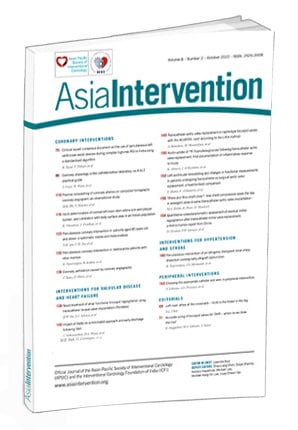Clinically significant left main coronary artery (LMCA) disease, defined as luminal narrowing of 50% or more, is seen in 5 to 7% of patients undergoing coronary angiography and in 24% of patients with acute coronary syndromes. A minimal lumen area <6.0 mm2, measured by intravascular ultrasound (IVUS), is the cut-off for percutaneous coronary intervention (PCI) or coronary artery bypass graft. Further study has elucidated that more than 80% of distal LMCA plaque extends into the left anterior descending artery (LAD), suggesting the importance of identifying the proximal landing zone when a coronary stent from the LAD to the LMCA is implanted. However, a racial difference in LMCA diameter may exist23. Thus, assessment of true coronary artery size is all the more essential for optimal stent sizing during LMCA-PCI.
In the current issue of AsiaIntervention4, Kirti Punamiya and colleagues present their analysis of 140 Indian patients who underwent IVUS-guided PCI to the LAD and left circumflex artery (LCx) and report that the IVUS-determined mean reference and luminal diameters of the LMCA were 5.53±0.63 mm and 4.62±0.65 mm, respectively. The results seemed inconsistent with the expected ethnic differences in LMCA diameter. Complementary to coronary angiography, IVUS provides in vivo tomographic anatomic information, enabling an evaluation from the lumen to the vessel wall. As a result, IVUS has had a pivotal role in advancing the understanding of the pathophysiology of coronary artery disease and in improving clinical outcomes. It provides preprocedural information to evaluate stenosis severity and plaque characteristics and helps with optimal stent deployment, minimising underexpansion and geographic miss, which are the major mechanisms of stent failure. With the development of the new generation of drug-eluting stents (DES), the position of IVUS in optimising stenting has not wavered.
One meta-analysis5 of 3,276 patients with only complex lesions was studied. At a mean of 1.4 years of follow-up, when compared with angiography-guided PCI, the patients who underwent IVUS-guided PCI had significantly lower major adverse cardiac events (MACE) and fewer target lesion revascularisations (TLR). There were no significant differences in stent thrombosis, cardiovascular death, or all-cause death. More recently, the pooled data of 2 randomised trials, IVUS-XPL and ULTIMATE, compared IVUS guidance versus angiography guidance in 2,577 patients with long lesions who were treated with an implanted stent length ≥28 mm6. At 3-year follow-up, the primary endpoint (cardiac death) occurred in 1.0% in the IVUS-guided group vs 2.2% in the angiography-guided group (p=0.011), along with a significant reduction of myocardial infarction (MI), stent thrombosis, and ischaemia-driven TLR. The reduction in cardiac death during long-term (>3 years) follow-up after an IVUS-guided procedure was also confirmed by another registry study7.
IVUS-guided optimal bifurcation stenting is reported to be correlated with reduced clinical events when compared with angiography guidance. Coronary bifurcations are prone to developing atherosclerotic plaque due to turbulent blood flow and high shear stress. These lesions amount to 15-20% of the total number of interventions. Although Murray’s law is useful to determine vessel diameters involving the proximal main vessel (MV), the distal MV, and the side branch (SB), an underestimation of vessel diameter is an insurmountable defect of angiography. Interestingly, in a multicentre, retrospective study8 with a total of 4,314 patients, early (30-day) outcomes were similar in the 2 groups. After 24±15 months, IVUS was not associated with any statistically significant impact on the risk of MACE, death, myocardial infarction, TLR or stent thrombosis. This may be at least partially due to the small side branches, low-risk patients, and the false bifurcations that were included, and that no exact optimal IVUS criteria were used, as in the IVUS-XPL and ULTIMATE trials6. In one study9 by Chen et al, 1,465 patients with unstable angina and Medina 1,1,1 or 0,1,1 coronary bifurcation lesions were prospectively studied. MACE occurred in 10.0% of patients at 1-year follow-up and 15.2% at the 7-year follow-up in the IVUS group, which was significantly different from 15.0% and 22.4% in the angiography group, respectively. Compared to angiography guidance, IVUS guidance also resulted in a lower 7-year rate of cardiac death, MI and any revascularisation.
A journey of a thousand miles begins with one step. The benefits of IVUS guidance for coronary bifurcation lesions could be enhanced by an ongoing clinical trial10. At this moment, it is crucial to resolve one key issue: how to increase the use of IVUS. Training and education provided either by society or industry is mandatory. The next technical issue is how to promote the achievements of IVUS-defined optimal procedures, as the ULTIMATE trial11 showed a similar MACE rate between suboptimal IVUS-defined procedures and those with angiographic guidance.
Conflict of interest statement
The author has no conflicts of interest to declare.

